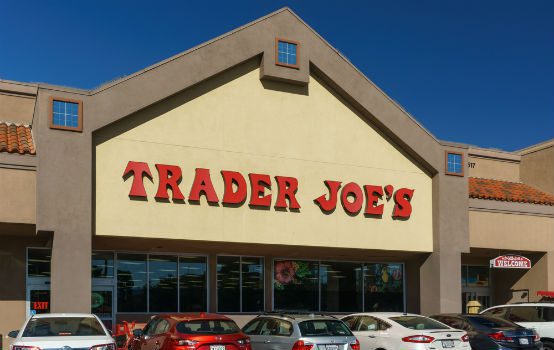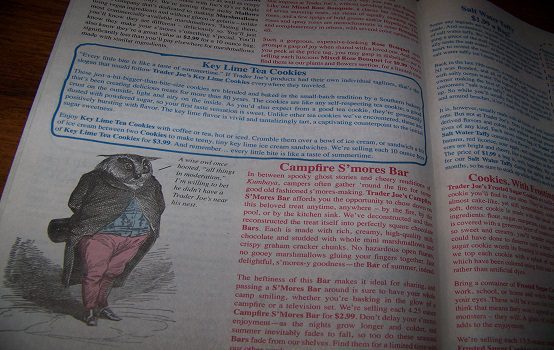Trader Joe’s: Good Food and Good Urbanism

If you follow my writing, you know that I don’t like a lot of things. That list, not exhaustively, includes the DMV, tiny hotel rooms, most modern movies, suburbia, and even brunch. A friend of mine recently remarked that I was like the modern Andy Rooney. (I’m not sure what surprised me more—that he knows who Andy Rooney was or that he reads my columns.)
I do like eating, though, and shopping for food. Northern Virginia is actually a great place for that. You can get classic Virginia foods like biscuits and country ham, but you can also find Italian delis, Ethiopian and Salvadoran groceries, large Chinese and Korean supermarkets—really almost any cuisine you want. There are also a bunch of Wegmans and Trader Joe’s locations, both of which are excellent places to shop and the latter of which I’m especially fond of.
But first, urbanism. Two things stand out about Trader Joe’s. The first is the relatively small building; the second is the infamous and equally small parking lot (this doesn’t apply, of course, to strip mall locations, though quite a few Trader Joe’s are freestanding buildings).
The stores, despite their compact sizes, are stuffed to the gills, which remedies one of the biggest problems with suburbia: the inefficient and unnecessary use of land. Earlier this year, I noted a shopping plaza in Northern Virginia that had one of the largest and emptiest parking lots I’d ever seen. This is actually required by zoning in most places; while the minimums vary from municipality to municipality, there are generally ordinances mandating X number of parking spaces for Y square feet of retail space.
So far, so good. For popular businesses, or on peak shopping days like Black Friday and the weekend or two before Christmas, that parking can come in handy. But for most of the year, much of it is empty. Heck, even at peak times a lot of it remains empty. That the minimums are already excessive is compounded by the fact that they don’t take into account vacancies, many of which end up being essentially permanent. (Who’s really going to take over every last Toys “R” Us or, now, Sears storefront? Years after their bankruptcies, it’s still possible to find vacant A&P or Pathmark buildings in New Jersey.) All the dying malls and plazas, and even those muddling along with one missing anchor or a bunch of empty small shops, are saddled with considerably more parking than they need. The environment suffers from a lack of greenery and permeable surfaces for flood control. And, it goes without saying, cracked, pockmarked asphalt doesn’t do much for aesthetics (though you can turn the lots into staging grounds for festivals).
What this has to do with Trader Joe’s is that by keeping things compact and not building more than the minimum parking, a Trader Joe’s location takes up about the same land as a CVS while providing at least as much utility as a Safeway, all with lower prices and environmental impacts. (The smaller real estate footprint produces savings for consumers.) This is actually something of a throwback—the first fully modern supermarkets, built in the early post-war years, were roughly the size of today’s drug stores. If you do some sleuthing with retail hobbyists and urban explorers, you’ll even find that a lot of modern drug stores actually inhabit former supermarket buildings.
Then there’s the distinctive Trader Joe’s motif: the bells, the Hawaiian shirts, the Frequent Flyer circular, the cheeky product names. The Flyer in particular is a treat to read, unlike almost any other piece of advertising or merchandising you can think of.

The whole shopping experience evokes a neighborhood or family-owned grocery crossed with a slightly touristy country farm store. It’s one of the only companies I can think of that has a consistent, distinctive aesthetic in both its products and physical stores, at least in the food business (Apple certainly qualifies, as does Dyson and probably Nintendo). If you stripped away the logos, displays, and store-brand products, you’d be hard-pressed to differentiate a Giant from a Safeway from a Martin’s from an Albertson’s from an Acme. You can’t mistake Trader Joe’s for anything else, and that’s probably a big part of their success.
And, of course, the food. The food items are quirky and very brand-specific. They’re not just generic copies of national brands, like most private labels and almost everything at Aldi, America’s other small-format, discount supermarket. Instead of 20 minutely different versions of everything, presenting an agonizing “paradox of choice,” there’s a wide array of distinct items. And, perhaps most delightful of all, they’re heavily seasonal. Like McDonald’s with its famous McRib, Trader Joe’s carries lots of limited products, for fall or the holidays or Easter or summer. The sample counter—there’s a sample counter in every store serving different products every day, all day—plays up the featured and seasonal items too. October might have hot or cold apple cider, Thanksgiving time might feature a turkey-stuffed puff pastry (one of my favorites), and major holidays might feature various dips or hors d’oeuvres.
There are a non-trivial number of local products in most stores (though it can be hard to tell which ones), and while many of the private label products are made by national manufacturers, a large share are unique and made by small contract manufacturers. You’re at least doing a little bit to help small businesses and break up the monotony of national mass manufacturing and merchandising.
My opinion, though, doesn’t mean much to the economy. If it did, we’d still have LaserDiscs and cathode ray tube televisions. But I’m not alone: Trader Joe’s consistently ranks among the most popular grocery chains in America.
All of this makes shopping at Trader Joe’s an activity, not just a chore. If you can’t go to the farmer’s market and your standard supermarket ignores the seasons and stocks harvest vegetables year-round and watermelons in winter, Trader Joe’s is the closest you can get to a livelier and more traditional kind of shopping. It’s a little taste of how—if we had to have it at all—the jungle of highways, parking lots, strip malls, and tilt-up big box stores that comprise so much of America could have been a little more pleasant if retailers had thought more about design and customer satisfaction. Trader Joe’s isn’t a charity or a park. It’s a business, and that makes it all the more remarkable.
Addison Del Mastro is assistant editor of The American Conservative. He tweets at @ad_mastro.
Comments